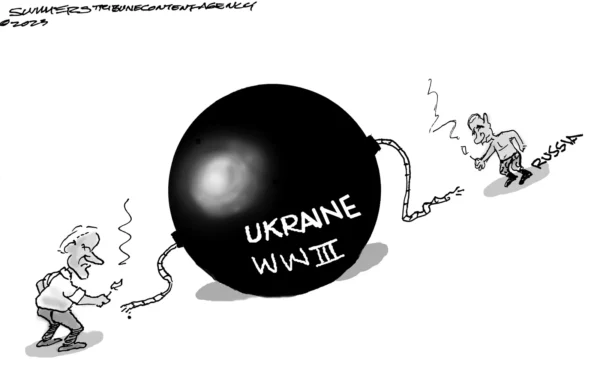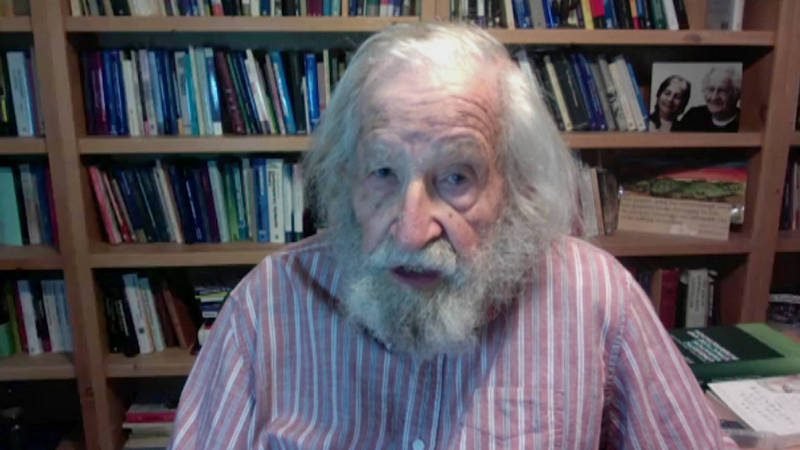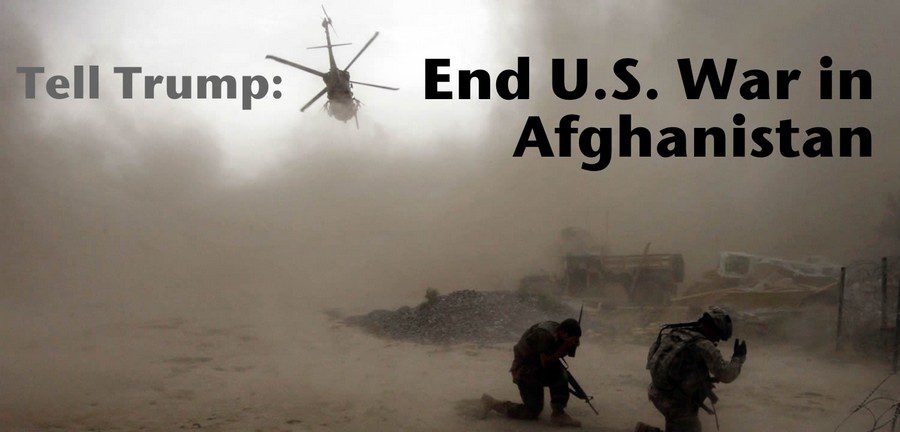
— By Medea Benjamin and Nicolas J. S. Davies, Naked Capitalism, Are We Stumbling Into World War III in Ukraine?
President Biden began his State of the Union speech with an impassioned warning that failing to pass his $61 billion dollar weapons package for Ukraine “will put Ukraine at risk, Europe at risk, the free world at risk.” But even if the president’s request were suddenly passed, it would only prolong, and dangerously escalate, the brutal war that is destroying Ukraine.
The assumption of the U.S. political elite that Biden had a viable plan to defeat Russia and restore Ukraine’s pre-2014 borders has proven to be one more triumphalist American dream that has turned into a nightmare. Ukraine has joined North Korea, Vietnam, Somalia, Kosovo, Afghanistan, Iraq, Haiti, Libya, Syria, Yemen, and now Gaza, as another shattered monument to America’s military madness.
This could have been one of the shortest wars in history, if President Biden had just supported a peace and neutrality agreement negotiated in Turkey in March and April 2022 that already had champagne corks popping in Kyiv, according to Ukrainian negotiator Oleksiy Arestovych. Instead, the U.S. and NATO chose to prolong and escalate the war as a means to try to defeat and weaken Russia.
Two days before Biden’s State of the Union speech, Secretary of State Blinken announced the early retirement of Acting Deputy Secretary of State Victoria Nuland, one of the officials most responsible for a decade of disastrous U.S. policy toward Ukraine.
Two weeks before the announcement of Nuland’s retirement at the age of 62, she acknowledged in a talk at the Center for Strategic and International Studies (CSIS) that the war in Ukraine had degenerated into a war of attrition that she compared to the First World War, and she admitted that the Biden administration had no Plan B for Ukraine if Congress doesn’t cough up $61 billion for more weapons.
….
The imperative must be to chart a path back from this hopeless but ever-escalating war of attrition to the negotiating table that the U.S. and Britain upended in April 2022 – or at least to new negotiations on the basis that President Zelenskyy defined on March 27, 2022, when he told his people, “Our goal is obvious: peace and the restoration of normal life in our native state as soon as possible.”
Instead, on February 26, in a very worrying sign of where NATO’s current policy is leading, French President Emmanuel Macron revealed that European leaders meeting in Paris discussed sending larger numbers of Western ground troops to Ukraine.
Macron pointed out that NATO members have steadily increased their support to levels unthinkable when the war began. He highlighted the example of Germany, which offered Ukraine only helmets and sleeping bags at the outset of the conflict and is now saying Ukraine needs more missiles and tanks. “The people that said “never ever” today were the same ones who said never ever planes, never ever long-range missiles, never ever trucks. They said all that two years ago,” Macron recalled. “We have to be humble and realize that we (have) always been six to eight months late.”
Macron implied that, as the war escalates, NATO countries may eventually have to deploy their own forces to Ukraine, and he argued that they should do so sooner rather than later if they want to recover the initiative in the war.
The mere suggestion of Western troops fighting in Ukraine elicited an outcry both within France–from extreme right National Rally to leftist La France Insoumise–and from other NATO countries. German Chancellor Olaf Scholz insisted that participants in the meeting were “unanimous” in their opposition to deploying troops. Russian officials warned that such a step would mean war between Russia and NATO.
But as Poland’s president and prime minister headed to Washington for a White House meeting on February 12, Polish Foreign Minister Radek Sikorski told the Polish parliament that sending NATO troops into Ukraine “is not unthinkable.”
Macron’s intention may have been precisely to bring this debate out into the open and put an end to the secrecy surrounding the undeclared policy of gradual escalation toward full-scale war with Russia that the West has pursued for two years.
Macron failed to mention publicly that, under current policy, NATO forces are already deeply involved in the war. Among many lies that President Biden told in his State of the Union speech, he insisted that “there are no American soldiers at war in Ukraine.”
However, the trove of Pentagon documents leaked in March 2023 included an assessment that there were already at least 97 NATO special forces troops operating in Ukraine, including 50 British, 14 Americans and 15 French. Admiral John Kirby, the National Security Council spokesman, has also acknowledged a “small U.S. military presence” based in the U.S. Embassy in Kyiv to try to keep track of thousands of tons of U.S. weapons as they arrive in Ukraine.
But many more U.S. forces, whether inside or outside Ukraine, are involved in planning Ukrainian military operations; providing satellite intelligence; and play essential roles in the targeting of U.S. weapons. A Ukrainian official told the Washington Post that Ukrainian forces hardly ever fire HIMARS rockets without precise targeting data provided by U.S. forces in Europe.
All these U.S. and NATO forces are most definitely “at war in Ukraine.” To be at war in a country with only small numbers of “boots on the ground” has been a hallmark of 21st Century U.S. war-making, as any Navy pilot on an aircraft-carrier or drone operator in Nevada can attest. It is precisely this doctrine of “limited” and proxy war that is at risk of spinning out of control in Ukraine, unleashing the World War III that President Biden has vowed to avoid.
The United States and NATO have tried to keep the escalation of the war under control by deliberate, incremental escalation of the types of weapons they provide and cautious, covert expansion of their own involvement. This has been compared to “boiling a frog,” turning up the heat gradually to avoid any sudden move that might cross a Russian “red line” and trigger a full-scale war between NATO and Russia. But as NATO Secretary General Jens Stoltenberg warned in December 2022, “If things go wrong, they can go horribly wrong.”
We have long been puzzled by these glaring contradictions at the heart of U.S. and NATO policy. On one hand, we believe President Biden when he says he does not want to start World War III. On the other hand, that is what his policy of incremental escalation is inexorably leading towards.
U.S. preparations for war with Russia are already at odds with the existential imperative of containing the conflict. In November 2022, the Reed-Inhofe Amendment to the FY2023 National Defense Authorization Act (NDAA) invoked wartime emergency powers to authorize an extraordinary shopping-list of weapons like the ones sent to Ukraine, and approved billion-dollar, multi-year no-bid contracts with weapons manufacturers to buy 10 to 20 times the quantities of weapons that the United States had actually shipped to Ukraine.
Retired Marine Colonel Mark Cancian, the former chief of the Force Structure and Investment Division in the Office of Management and Budget, explained, “This isn’t replacing what we’ve given [Ukraine]. It’s building stockpiles for a major ground war [with Russia] in the future.”
So the United States is preparing to fight a major ground war with Russia, but the weapons to fight that war will take years to produce, and, with or without them, that could quickly escalate into a nuclear war. Nuland’s early retirement could be the result of Biden and his foreign policy team finally starting to come to grips with the existential dangers of the aggressive policies she championed.
….
Reuters Moscow Bureau reported that Russia spent months trying to open new negotiations with the United States in late 2023, but that, in January 2024, National Security Adviser Jake Sullivan slammed that door shut with a flat refusal to negotiate over Ukraine.
The only way to find out what Russia really wants, or what it will settle for, is to return to the negotiating table. All sides have demonized each other and staked out maximalist positions, but that is what nations at war do in order to justify the sacrifices they demand of their people and their rejection of diplomatic alternatives.
Bruce Gerencser, 66, lives in rural Northwest Ohio with his wife of 45 years. He and his wife have six grown children and thirteen grandchildren. Bruce pastored Evangelical churches for twenty-five years in Ohio, Texas, and Michigan. Bruce left the ministry in 2005, and in 2008 he left Christianity. Bruce is now a humanist and an atheist.
Connect with me on social media:
Your comments are welcome and appreciated. All first-time comments are moderated. Please read the commenting rules before commenting.
You can email Bruce via the Contact Form.


